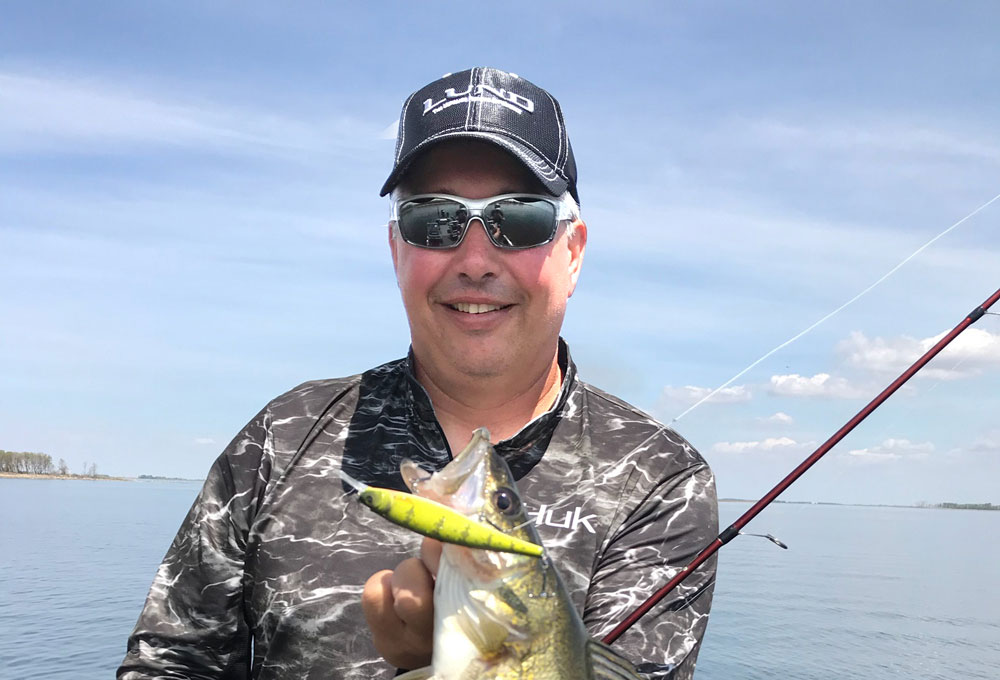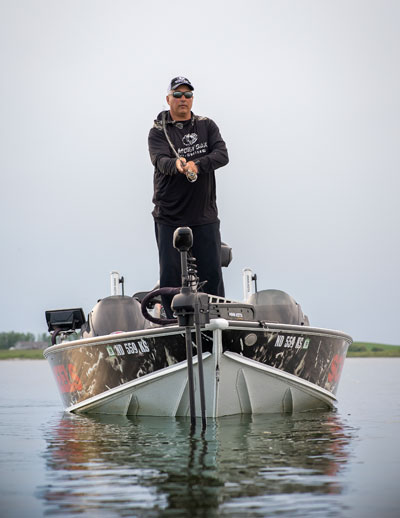provided by John E. Phillips
Mossy Oak Pro Johnnie Candle, from Devils Lake, North Dakota, has been a walleye tournament fisherman since 1994. He won the 2010 World Walleye Championship and in a normal year, would fish 6-10 walleye tournaments held all over the country. Candle also guides on Devils Lake as a professional angler. This week he shares information with us on spring fishing for walleyes.

I run four depth finders on my boat, one Humminbird Helix 10 and one Helix 12 on the console in the center of my boat and a Helix 10 and 12 on the front of the boat. I have two depth finders in the front of the boat because that’s where I drive with my trolling motor when we’re fishing. I have two depth finders in the back of the boat because that’s where I'm sitting when I'm searching for fish.
On some days, I’d use two more units if I could. Before, if I had one flasher on my boat, I only had as much information about the fish as I could get at that time. Though now, because electronics can provide much much more information for a fisherman than ever before, I can see all of the information on one screen. On my depth information finder, I can run two screens on one finder and two more on the other to see tons of info that directly dictate where I'll fish for how long and probably what kind of lures I need to be successful with walleyes.
 When I first started tournament fishing, we didn't have electronics. Instead, we had depth finders that measured the depth of the water and the contour of the lake’s bottom. If you spent enough time on it, you could even see fish and know exactly where they were located. Today, my depth finders have 2D sonar, a down-imaging sonar, a side-imaging sonar, a 360-degree sonar, lake maps, water temperature gauges, speedometers and a GPS and also can drive my trolling motor through my Humminbird Helix lake map system. There isn’t enough screen space to interpret all of the information at once, and if you can combine all of the features of these four electronics, you’ll need an 80-inch screen on the front of your boat, about the size of a large screen TV. That screen will take up way too much space to fish and navigate your boat. So, the more units you have in the front of your boat and on your casting deck, the better you can see critical information that directly affects your ability to find and catch fish and operate your outboard trolling motor.
When I first started tournament fishing, we didn't have electronics. Instead, we had depth finders that measured the depth of the water and the contour of the lake’s bottom. If you spent enough time on it, you could even see fish and know exactly where they were located. Today, my depth finders have 2D sonar, a down-imaging sonar, a side-imaging sonar, a 360-degree sonar, lake maps, water temperature gauges, speedometers and a GPS and also can drive my trolling motor through my Humminbird Helix lake map system. There isn’t enough screen space to interpret all of the information at once, and if you can combine all of the features of these four electronics, you’ll need an 80-inch screen on the front of your boat, about the size of a large screen TV. That screen will take up way too much space to fish and navigate your boat. So, the more units you have in the front of your boat and on your casting deck, the better you can see critical information that directly affects your ability to find and catch fish and operate your outboard trolling motor.
So what does each unit tell me? I use the Humminbird Helix 12 strictly for sonar. I want the biggest screen possible to see what’s going on under and around my boat. I'll probably have my 2D sonar and side-imaging sonar on the Helix 12 depth finders. On the Helix 10, I’ll use a mapping feature on one screen that helps me find and stay on the structure that I want to fish on, and another may help me drive my trolling motor.
The reason I have duplicate consoles on the front and back of my boat is because I spend a lot of time driving around, looking for structure and fish. Once I see fish, I go to the front of the boat and start looking at those depth finders, because I know that there are fish around the boat. If there is one place where I can have sonar, it will be the front of the boat. However, when I'm sitting behind the console, I’ll often set my side imaging to scan 100 feet on either side of the boat and have the 2D sonar looking right under the boat. I’d also use mapping to see exactly where I'm at on the lake, and where the structure is, and decide if I want to make my own map on the console.
I don't want to leave the steering wheel of my boat until I'm absolutely certain I can see a fish that I can catch. I prefer to drive around an hour looking for fish and spend five to ten minutes trying to catch them instead of spending an hour fishing a place where there aren’t any walleyes. I really want to make sure that I have a possibility of catching a fish before I start casting.
To see the kind of fish John Candle is producing, you can go to his website www.johnniecandle.com or call him at 701-371-9431.



























